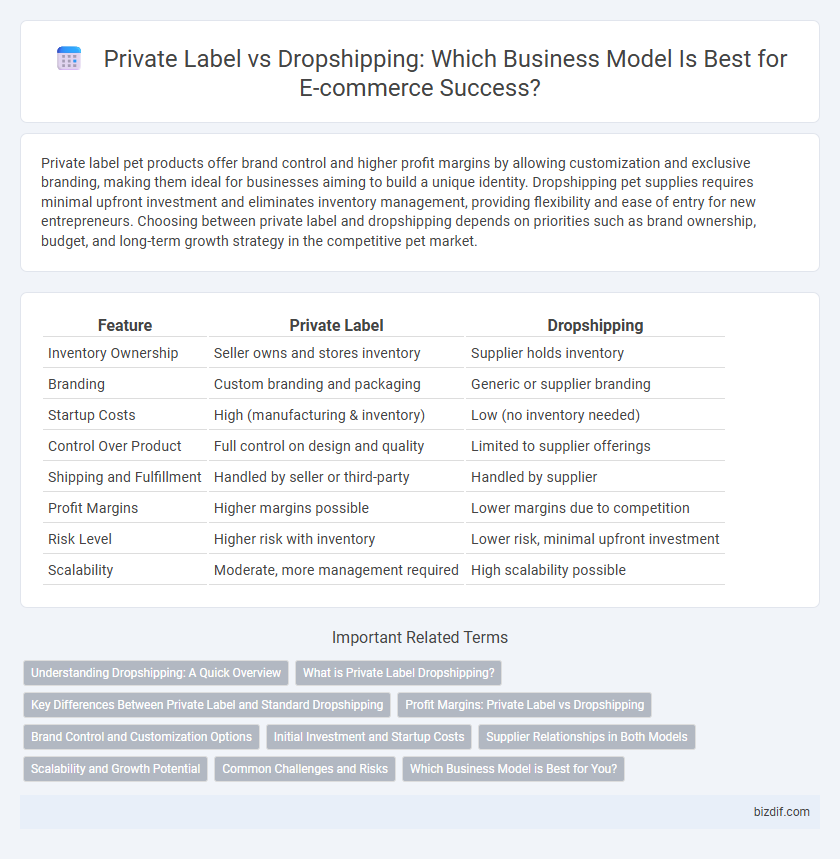Private label pet products offer brand control and higher profit margins by allowing customization and exclusive branding, making them ideal for businesses aiming to build a unique identity. Dropshipping pet supplies requires minimal upfront investment and eliminates inventory management, providing flexibility and ease of entry for new entrepreneurs. Choosing between private label and dropshipping depends on priorities such as brand ownership, budget, and long-term growth strategy in the competitive pet market.
Table of Comparison
| Feature | Private Label | Dropshipping |
|---|---|---|
| Inventory Ownership | Seller owns and stores inventory | Supplier holds inventory |
| Branding | Custom branding and packaging | Generic or supplier branding |
| Startup Costs | High (manufacturing & inventory) | Low (no inventory needed) |
| Control Over Product | Full control on design and quality | Limited to supplier offerings |
| Shipping and Fulfillment | Handled by seller or third-party | Handled by supplier |
| Profit Margins | Higher margins possible | Lower margins due to competition |
| Risk Level | Higher risk with inventory | Lower risk, minimal upfront investment |
| Scalability | Moderate, more management required | High scalability possible |
Understanding Dropshipping: A Quick Overview
Dropshipping is a retail fulfillment method where stores don't keep products in stock but instead transfer customer orders directly to suppliers who ship items to buyers. Unlike private labeling, which involves creating and branding custom products, dropshipping allows sellers to offer a broad product range without inventory management or upfront investment. This model minimizes risk and operational costs, enabling entrepreneurs to test markets swiftly and scale efficiently.
What is Private Label Dropshipping?
Private label dropshipping involves selling products under your own brand name, sourced from suppliers who handle inventory and shipping directly to customers. This model combines the benefits of dropshipping with brand customization, allowing merchants to create unique packaging, logos, and marketing materials. Private label dropshipping helps build brand identity and customer loyalty without the need for upfront inventory investment.
Key Differences Between Private Label and Standard Dropshipping
Private label involves creating and branding your own products, offering greater control over quality and customer experience, whereas standard dropshipping relies on third-party suppliers who handle inventory and shipping. Private label requires upfront investment in product development and branding, while dropshipping minimizes initial costs by using existing products without inventory risk. The key differences hinge on control, customization, and branding opportunities versus ease of entry and lower upfront expenses.
Profit Margins: Private Label vs Dropshipping
Private label products typically offer higher profit margins compared to dropshipping due to better brand control and reduced competition, allowing sellers to price items more strategically. Dropshipping margins are generally lower because of increased competition and reliance on third-party suppliers, leading to thinner profits per sale. Optimizing profit margins in private label requires upfront investment in product development and branding, while dropshipping minimizes initial costs but sacrifices potential earnings.
Brand Control and Customization Options
Private label dropshipping offers greater brand control by allowing sellers to customize packaging, labels, and product features, creating a unique customer experience. Traditional dropshipping limits customization options since products are sold under the supplier's brand, reducing opportunities for differentiation. Enhanced customization in private label dropshipping fosters brand loyalty and enables tailored marketing strategies.
Initial Investment and Startup Costs
Private Label typically demands a higher initial investment due to product development, branding, and inventory costs, often ranging from $2,000 to $10,000 or more. Dropshipping minimizes startup expenses by eliminating inventory purchases, requiring only website setup and marketing expenses, which can be as low as $100 to $500. Entrepreneurs seeking lower financial risk often prefer dropshipping, while those aiming for brand control and higher profit margins lean towards private labeling.
Supplier Relationships in Both Models
Private label requires building close, long-term supplier relationships to customize products and ensure consistent quality, fostering brand identity control. Dropshipping relies on more transactional, flexible supplier connections, often dealing with multiple vendors to fulfill varied customer orders without inventory management. Strong communication and reliability remain critical in both models to maintain product availability and customer satisfaction.
Scalability and Growth Potential
Private label offers higher scalability and growth potential by enabling brand control, unique product differentiation, and higher profit margins through exclusive manufacturing. Dropshipping allows rapid business launch and low upfront investment but faces scalability limits due to supplier dependency and lower profit margins. Entrepreneurs prioritizing long-term growth often choose private label to build brand equity and optimize supply chains for sustained expansion.
Common Challenges and Risks
Private label and dropshipping both face challenges such as inventory management, supplier reliability, and quality control, but private label requires upfront investment in product development and branding, increasing financial risk. Dropshipping often struggles with longer shipping times, lack of control over fulfillment, and potential supplier stockouts, leading to customer dissatisfaction. Both models risk reduced profit margins due to intense competition; however, private label offers more brand differentiation, whereas dropshipping depends heavily on third-party suppliers.
Which Business Model is Best for You?
Private label offers higher profit margins and stronger brand control by allowing you to create unique, customized products, while dropshipping requires less upfront investment and eliminates inventory risks by fulfilling orders directly from suppliers. Choosing the right model depends on your budget, marketing skills, and long-term business goals, with private label ideal for those seeking brand ownership and scalability, and dropshipping suited for beginners or those testing multiple niches. Analyze factors like startup costs, supplier reliability, product differentiation, and customer loyalty potential to determine which business model aligns best with your resources and ambitions.
Private Label vs Dropshipping Infographic

 bizdif.com
bizdif.com